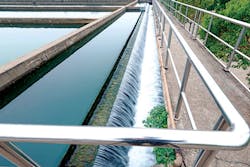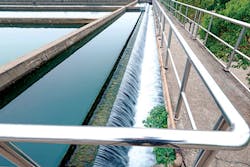Wastewater Reuse, Recycling Poised for Expansion
By Thacher Worthen
The water reuse segment of the water industry has experienced rapid growth and gone through tremendous change over the last several years. The global demand for increased water supplies has driven the development of alternative water sources, including reclaimed wastewater. A 2012 study by the National Science Foundation stated that U.S. coastal cities could increase their water supplies by 27 percent with treated wastewater. Population growth and other demographic factors are likely to further drive water demand in the future.
There has been an increased interest in the beneficial reuse of wastewater of all types, both in the U.S. and abroad. In the U.S., the areas that have been the historical leaders in the water reuse market include California, Florida, Arizona, and Texas. For instance, the current volume of wastewater reused in Florida is estimated to exceed 750 MGD. The recent cycles of drought in California and Texas resulted in multiple pilot or demonstration projects that involve potential indirect and direct potable reuse schemes. State and national regulatory bodies have been developing guidelines and regulations so they can approve and license these types of facilities.
Landscape and agricultural irrigation have been the largest users of water reuse in the municipal sector. For example, in Israel about 80 percent of the municipal wastewater discharged is reclaimed and much of this is used for agricultural irrigation. The second largest use for reclaimed water is for groundwater recharge. Examples include aquifer replenishment in Wichita, Kan., and to protect barrier wells against saltwater intrusion in southern California. The third area of use is the industrial and commercial area where reclaimed water is being used for such things as cooling tower make-up, boiler feedwater, internal plant process water, and production use.
Filtration is a key unit operation in water reclamation, providing a separation of suspended and colloidal particles, including microorganisms, from water. Depth filtration was the most common method used for the filtration of wastewater effluent. In addition to providing supplemental removal of suspended solids, depth filtration is used as a conditioning step for effective disinfection. At larger reuse facilities, until recently, mono- and dual-media filters were the most commonly used for wastewater filtration with gravity or pressure as the driving force.
More recently, surface filtration has been used for tertiary filtration or as pretreatment for membrane filtration or ultraviolet disinfection. In surface filtration, particulate matter is removed by mechanical means by passing water through media that includes thin filter material that can be composed of cloth fabrics, woven metal fabrics, or compressible media of synthetic materials. Advantages of the newer processes include more flexibility and more consistent operation at higher flux rates than possible with depth filtration, which translates to less space required for the filtration process.
While wastewater can be treated and reused for a wide variety of purposes, the end use dictates what type of unit processes and final water quality are required. At a minimum, the processes utilized are tertiary filtration and progress to various levels of additional required treatment depending on the end use. For example, cooling tower make-up or boiler feedwater requires advanced biological treatment and reverse osmosis for boiler process water.
In summary, the reuse of wastewater for many different applications will continue to increase in the future. Its application will expand across the U.S. as critical stakeholders understand the potential and benefits to all involved.
About the Author: Thacher Worthen is president of Schreiber LLC (Trussville, Ala.) and a member of the Water and Wastewater Equipment Manufacturers Association (WWEMA). He serves on the WWEMA Board of Directors and is chair-elect of the association, which formed in 1908 to be the voice of equipment manufacturers in the water and wastewater industry. More information about WWEMA can be found at www.wwema.org.

